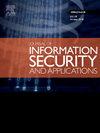ThreatCog:一种具有增强运动传感信号的自适应轻量级移动用户认证系统
IF 3.7
2区 计算机科学
Q2 COMPUTER SCIENCE, INFORMATION SYSTEMS
Journal of Information Security and Applications
Pub Date : 2025-07-10
DOI:10.1016/j.jisa.2025.104142
引用次数: 0
摘要
移动应用程序的广泛采用推动了各种移动设备用户身份验证方法的发展。最近,已经引入了基于运动传感器的移动用户身份验证方法,通过利用被动传感器数据提供入口点身份验证,而无需用户交互。然而,现有的基于运动传感器信号的方法面临着以下几个挑战:(1)对运动传感器数据的处理不足,导致用户行为特征提取不准确;(2)捕获常见用户行为的能力不足;(3)增加新用户时需要高数据要求和再培训努力。在本文中,我们介绍了一种轻量级的自适应移动用户认证系统ThreatCog,该系统增强了对运动传感器信号的利用,包括加速度计、陀螺仪和重力传感器。为了解决第一个挑战,我们的方法使用信号增强技术使用户行为特征在数据中更加突出。对于第二个挑战,在训练期间,系统采用注意机制来提取用户之间的共同行为特征,从而允许有效的身份验证,而无需区分各种用户行为上下文。最后,为了克服第三个挑战,系统使用少量学习来支持新用户,通过n-shot测试验证身份验证有效性,其中在注册阶段只需要少量样本。在移动设备上的大量实验表明,ThreatCog可以实现快速准确的用户身份验证。值得注意的是,ThreatCog达到了令人印象深刻的98%的准确率,优于SOTA系统。本文章由计算机程序翻译,如有差异,请以英文原文为准。
ThreatCog: An adaptive and lightweight mobile user authentication system with enhanced motion sensory signals
The widespread adoption of mobile applications has driven the development of various user authentication methods for mobile devices. Recently, motion sensor-based mobile user authentication methods have been introduced to offer point-of-entry authentication by utilizing passive sensor data without requiring user interaction. Nonetheless, existing methods based on motion sensor signals face several challenges: (1) inadequate processing of motion sensor data, leading to inaccurate user behavior feature extraction, (2) insufficient capability to capture common user behaviors, and (3) high data requirements and retraining efforts needed when adding new users.
In this paper, we introduce ThreatCog, a lightweight and adaptive mobile user authentication system that enhances the utilization of motion sensory signals, including accelerometers, gyroscopes, and gravity sensors. To address the first challenge, our method uses signal enhancement technique to make user behavior features more prominent in the data. For the second challenge, during training, the system employs an attention mechanism to extract common behavioral characteristics across users, allowing effective authentication without the need to differentiate between various user behavior contexts. Finally, to overcome the third challenge, the system uses few-shot learning to support new users, validating authentication effectiveness through n-shot testing, where only a small number of samples are required during the registration phase. Extensive experiments on mobile devices demonstrate that ThreatCog enables fast and accurate user authentication. Notably, ThreatCog achieves an impressive 98% accuracy, outperforming SOTA systems.
求助全文
通过发布文献求助,成功后即可免费获取论文全文。
去求助
来源期刊

Journal of Information Security and Applications
Computer Science-Computer Networks and Communications
CiteScore
10.90
自引率
5.40%
发文量
206
审稿时长
56 days
期刊介绍:
Journal of Information Security and Applications (JISA) focuses on the original research and practice-driven applications with relevance to information security and applications. JISA provides a common linkage between a vibrant scientific and research community and industry professionals by offering a clear view on modern problems and challenges in information security, as well as identifying promising scientific and "best-practice" solutions. JISA issues offer a balance between original research work and innovative industrial approaches by internationally renowned information security experts and researchers.
 求助内容:
求助内容: 应助结果提醒方式:
应助结果提醒方式:


